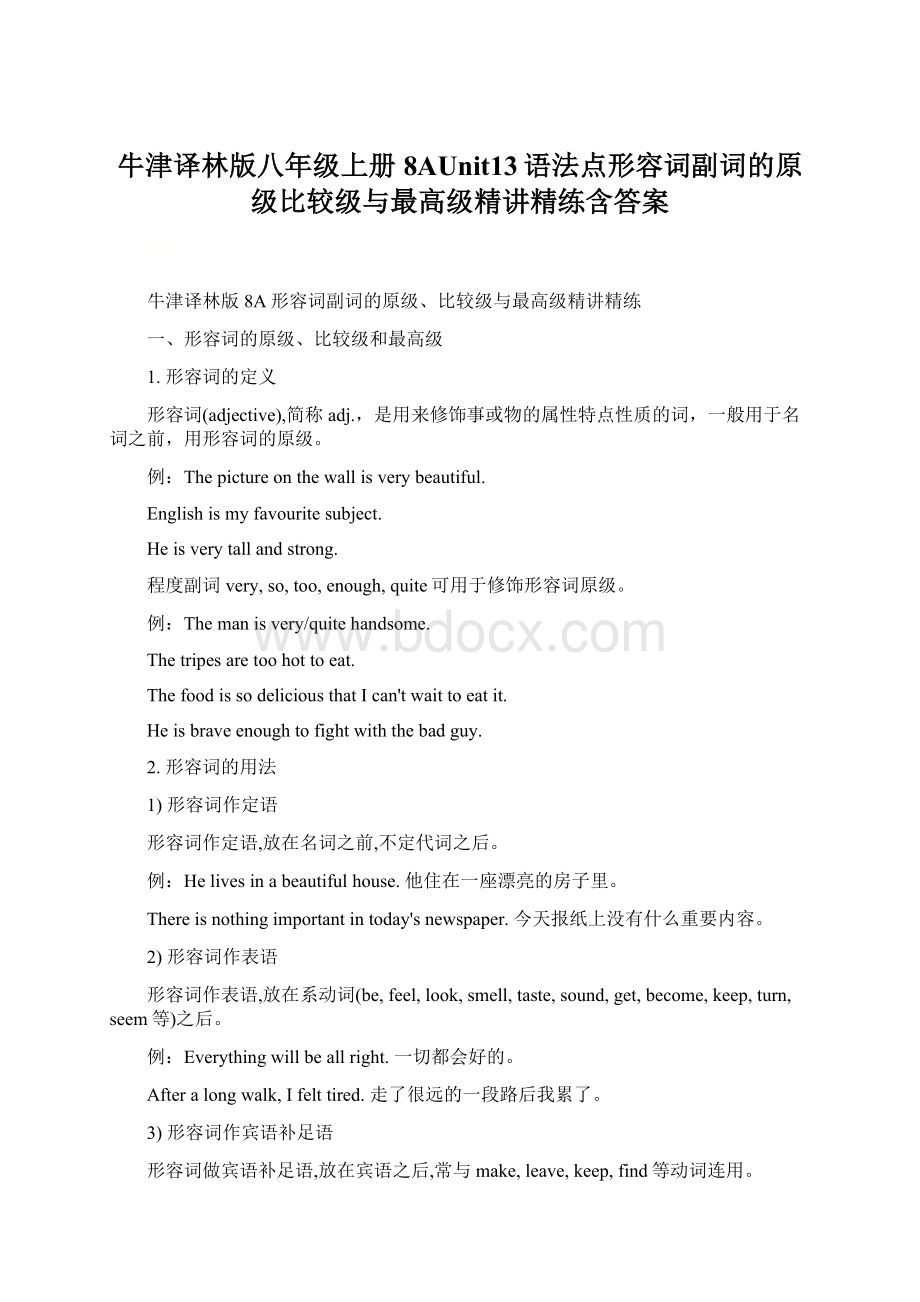牛津译林版八年级上册8AUnit13语法点形容词副词的原级比较级与最高级精讲精练含答案.docx
《牛津译林版八年级上册8AUnit13语法点形容词副词的原级比较级与最高级精讲精练含答案.docx》由会员分享,可在线阅读,更多相关《牛津译林版八年级上册8AUnit13语法点形容词副词的原级比较级与最高级精讲精练含答案.docx(20页珍藏版)》请在冰豆网上搜索。

牛津译林版八年级上册8AUnit13语法点形容词副词的原级比较级与最高级精讲精练含答案
牛津译林版8A形容词副词的原级、比较级与最高级精讲精练
一、形容词的原级、比较级和最高级
1.形容词的定义
形容词(adjective),简称adj.,是用来修饰事或物的属性特点性质的词,一般用于名词之前,用形容词的原级。
例:
Thepictureonthewallisverybeautiful.
Englishismyfavouritesubject.
Heisverytallandstrong.
程度副词very,so,too,enough,quite可用于修饰形容词原级。
例:
Themanisvery/quitehandsome.
Thetripesaretoohottoeat.
ThefoodissodeliciousthatIcan'twaittoeatit.
Heisbraveenoughtofightwiththebadguy.
2.形容词的用法
1)形容词作定语
形容词作定语,放在名词之前,不定代词之后。
例:
Helivesinabeautifulhouse.他住在一座漂亮的房子里。
Thereisnothingimportantintoday'snewspaper.今天报纸上没有什么重要内容。
2)形容词作表语
形容词作表语,放在系动词(be,feel,look,smell,taste,sound,get,become,keep,turn,seem等)之后。
例:
Everythingwillbeallright.一切都会好的。
Afteralongwalk,Ifelttired.走了很远的一段路后我累了。
3)形容词作宾语补足语
形容词做宾语补足语,放在宾语之后,常与make,leave,keep,find等动词连用。
例:
Hekeepstheclassroomcleaneveryday.他们每天保持教室干净。
Peopleusuallykeepthevegetablesfreshinthefridge.人们常把蔬菜放在冰箱里保鲜。
4)形容词的名词化,“the+形容词”表示一类人,相当于名词,用作主语或宾语。
例:
Theoldoftenthinkofoldthings.老人常想起过去的事情。
Theyaregoingtobuildaschoolforthedeafandtheblind.他们将要给聋人和盲人盖一所学校。
5)形容词作状语
例:
Thesesoldiersspentthreedaysinthecoldweather,coldandhungry.
这些士兵们在冷天里度过了三天,又冷又饿。
Helayinbed,awake.他躺在床上,醒着。
Sureenough,shewasthere.果然,她在那。
6)形容词的先后顺序
如果有两个或两个以上的形容词修饰一个名词时,形容词的先后顺序由它们和被修饰的名词之间的密切程度而定,越密切的形容词越靠近名词。
如果几个形容词的密切程度差不多则按音节少的形容词放在前面,音节多的形容词放在后面。
为方便记忆,可记住一句话:
美小圆新黄,法国木书房。
限定词
数词
性状形容词
冠词、指示代词、物主代词
序数词
基数词
描绘性形容词
形状、大小
长短、高低
年龄、新旧、温度
颜色
国籍地区出处
材料物质
目的
用途
a(n)
the
this
my
his
first
second
third
one
two
three
good
kind
sick
rude
nice
little
big
large
long
round
square
old
new
hot
cold
white
yellow
red
black
British
Chinese
Asian
eastern
cotton
metal
stone
silk
writing
medical
2.形容词的同级比较
★同级比较,即表示两者(A与B)在某一方面相同时用句型:
A+谓语+as+形容词+as+B表示“和…一样”
例:
EnglishisasimportantasMaths.英语和数学一样重要。
YouareastallasJim.你和吉姆一样高。
A+谓语+not+as/so+形容词+as+B表示“和…不一样,A不如B…”
例:
Youarenotas/sotallasJim.你和吉姆不一样高。
(你没有吉姆高/你比吉姆矮)
Thisbookisnotas/sointerestingasthatone.这本书没有那本书有趣。
3.形容词的比较级与最高级
当我们将两个对象进行比较时,我们要用形容词的比较级,表示“较…”、“更…一些”、“比…更…”
当被比较的对象是三个或三个以上时,我们要用形容词的最高级,表示“最…”
被比较的对象可以是人也可以是事或物。
★形容词最高级前面通常要加定冠词the
形容词的比较级和最高级构成方法如下表:
词尾变化
原级
比较级
最高级
单音节和部分双音节词
大多数后加er或est
great
young
high
hard
small
new
greater
younger
higher
harder
smaller
newer
greatest
youngest
highest
hardest
smallest
newest
以e结尾的词后加r或st
safe
late
large
nice
safer
later
larger
nicer
safest
latest
largest
nicest
以一个辅音字母结尾的重读闭音节词,双写最后一个字母,再加er或est
big
hot
thin
bigger
hotter
thinner
biggest
hottest
thinnest
以辅音字母+y结尾的词,去掉y,再加ier或iest
early
easy
busy
friendly
earlier
easier
busier
friendlier
earliest
easiest
busiest
friendliest
多音节和部分双音节词
在词前面
加more或most
careful
beautiful
useless
serious
glad
tired
morecareful
morebeautiful
moreuseless
moreserious
moreglad
moretired
mostcareful
mostbeautiful
mostuseless
mostserious
mostglad
mosttired
不规则变化
无具体,需单独记忆
good/well
bad/ill
many/much
little
far
old
better
worse
more
less
farther/further
older/elder
best
worst
most
least
farthest/furthest
oldest/eldest
★形容词比较级常见于以下句式:
1)通常情况下,我们用“比较级+than”来引出比较的第二部分。
例:
Youaretallerthanhim/heis.
Thisstoryismoreinterestingthanthatone.
2)我们用“Which/Who…+比较级,…or…?
”的句型来表示在两者中选择。
例:
Whichisbigger,thesunortheearth?
Whoistaller,TomorTerry?
3)我们可在比较级前加上alittle,abit,agreatdeal,alot,much,even,still,far,any等副词表示程度。
例:
ChinaismuchlargerthanJapan.
Iamalittletallerthanhim.
4)我们用“比较级+and+比较级”或“moreandmore+原级”的结构表示人或事物本身程度的改变。
例:
Theboysaregettingstrongerandstronger.
ItisbecomingmoreandmorepopularforyoungpeopletorecordtheirliveswithTikTok.
5)“倍数/岁数+比较级+than…”表示“比...大(小)多少倍/多少岁”
例:
Thisgardenisfourtimeslargerthanthatone.
Mybrotheristhreeyearsolderthanme.
6)“比较级+thananyother+名词单数”表示“…比任何…都…”用于同一类人或物在某同一范围内比较。
例:
Mikeistallerthananyotherboyinhisclass.(Mike也是这个班里的)
=Mikeistallerthanotherboysinhisclass.
=Mikeisthetallestboyinhisclass.
ChinaislargerthananyothercountryinAsia.
7)“比较级+thanany+名词单数”表示“…比任何…都…”用于同一类人或物在不同范围内比较。
例:
Mikeistallerthananyboyinmyclass.(Mike不是我们班的)
ShanghaiislargerthananycityinShandong.
8)“the+比较级+ofthetwo”突出两者中更...的那一个
例:
Mikeisthetallerofthetwo.
9)“less+形容词的原级+than”表示“不如、不及”。
例:
Thiscomputerislessexpensivethanthatone.
10)“the+比较级…,the+比较级…”表示一方程度随另一方程度变化而变化,意为“越…就越…”
例:
Theolderyougrow,thewiseryouwillbecome.
Themoredifficulttheproblemis,themorecarefulweshouldbe.
11)“not+比较级+than”表示一方不如另一方
*“no+比较级+than”表示前者和后者一样都不
例:
Iamnottallerthanyou.我没有你高。
Iamnotallerthanyou.我们都不高。
★形容词最高级常见于以下句式:
1)我们用“形容词性物主代词+最高级”的结构表示某人或某事的“最…”
例:
Peterishisoldestson.皮特是他最年长的儿子。
2)用“the+最高级+比较范围”的结构来表示某一范围的“最…”
可以用介词of和among后面接表示范围的人或物,in后面接表示范围的名词和名词性短语
例:
Iamthetallestof/amongthethree.
Russiaisthelargestcountryintheworld.
3)用“the+序数词+最高级+名词单数+范围”表示“在…中是第几…”
例:
Chinaisthethirdlargestcountryintheworld.
4)用“oneofthe+最高级+名词复数”表示“最…的…之一”
例:
Oneofthemostimportantqualitiesishonesty.
Chinaisoneofthelargestcountriesintheworld.
【注意】oneof有三大考点:
1.后跟形容词最高级;2.后接可数名词复数形式;3.作主语时主语为one,故谓语动词用单数形式
写出下列形容词的比较级和最高级
原级
比较级
最高级
原级
比较级
最高级
long
well
large
thin
hot
good
bad
little
delicious
much
early
fast
difficult
hard
many
far
old
often
busy
tall
slow
small
few
smart
nice
late
brave
funny
happy
lazy
heavy
dirty
beautiful
interesting
dangerous
polite
expensive
important
careful
quick
适当形式填空
1.Heis3timesas__________(old)asme.
2.I'mtootiredtogoany_____________.(far)
3.Whois____________(clever),LilyorLucy?
4.Tomisthe_____________(heavy)ofthethree.
5.Tomisthe_____________(heavy)ofthetwoboys.
6.Russiais_____________(large)thananyothercountryintheworld.
7.Hiscomputeristhe_________________(expensive)ofall.
8.Youarepretty_____________(beautiful).
9.Thebookis______________(useful)thanthatone.
10.Who'sthe_______________(healthy),you,heorshe?
11.How______________(small)theshirtis!
Iwanta______________(big)one.
12.Ifeelmuch_______________(excited)now.
13.Soccerisbecoming___________and___________________________(popular)inChina.
14.The______________(much)youpractice,the________________(good)yourEnglishwillbe.
15.It'sthethird___________________(long)riverinChina.
二、副词的原级,比较级和最高级
1.副词的定义
副词(Adverb简称adv.)是指在句子中表示行为或状态特征的词,用以修饰动词、形容词、其他副词或全句,表示时间、地点、程度、方式等概念。
2.副词的分类
副词可分为:
时间副词、频率副词、地点副词、方式副词、程度副词、疑问副词、连接副词、关系副词、表顺序、表完成的副词等。
1)时间频率副词:
now,then,often,always,usually,next,already(已经),generally(一般地),frequently(频繁地),seldom/hardly(很少的),ever,never,yet,soon,too,immediately(立即),finally,shortly(很快),before,ago,sometimes,yesterday,once,twice,lately,recently,personally,today
2)地点副词:
here,there,everywhere,anywhere,somewhere,in,out,inside,outside,above,below,up,down,back,forward(向前的),home,upstairs(楼上的),downstairs,across,along,round,around,near,off,past,up,away,on
3)方式副词:
carefully,properly(适当地),anxiously(焦虑地),suddenly,normally(正常地),fast,well,calmly(冷静地),politely(礼貌地),proudly(自豪地),softly,warmly,slowly,badly,hard,bravely
4)程度副词:
much,little,very,rather(相当),so,too,still,quite,perfectly(完美地),enough,extremely(非常),entirely(整个),almost,slightly(细小地),hardly
5)疑问副词:
how,when,where,why
6)关系副词:
when,where,why
7)连接副词:
therefore(因此),moreover,however,otherwise,then,when,where,how,why
8)表顺序的副词:
first,then,next,finally,afterwards,primarily
9)完成时的副词:
already,ever,just,never,since,yet,recently
3.副词的放置位置
1)多数副词放在动词后面,或者放在be动词、助动词或情态动词之后,实义动词之前。
如果实义动词后有宾语,则放于宾语之后。
例:
IamalsoBush.我也是布什。
Icanalsodothat.我也可以这样做。
Ialsowanttoplaythatgames.我也想玩这游戏。
Igetupearlyinthemorningeveryday.每一天的早晨我都起得很早。
Wecangotothisschoolfreely.我们可以免费到这家学校学习。
Theyleftalifehardlythen.当时他们的生活很艰难。
2)副词修饰形容词时,一般放在被修饰词之前,但enough除外。
例:
It'srathereasy,Icandoit.这很容易,我能做到。
Hediditquitewell.他做得相当好。
It'sratherdifficulttotellwhoisright.很难说谁是对的。
Hedidn'trunfastenoughtocatchthetrain.他的奔跑速度不足以快到能够追上火车。
3)频度副词可放在实义动词的前面,情态动词和助动词的后面。
例:
Ioftenhelphimthesedays.这些日子我经常帮助他。
IalwaysrememberthedaywhenIfirstcametothisschool.
Youcouldn'talwayshelpme.你不能老是帮助我。
Weusuallygoshoppingonceaweek.我们通常一周买一次东西。
Thenewstudentsdon'talwaysgotodance.新学生并不时常去跳舞。
4)疑问副词,连接副词,关系副词以及修饰整个句子的副词,通常放在句子或从句的前面。
例:
Whendoyoustudyeveryday?
你每天什么时间学习?
First,letmeaskyousomequestions.先让我来问几个问题。
5)时间副词和地点副词在一个句中,地点副词在前面,时间副词在后面。
例:
Wewentshoppinginthesupermarketat9o'clockyesterday.
昨天九点钟我们到超市买东西了.
Whatwereyoudoingintheclassroomyesterdayafternoon?
昨天下午你在教室里干什么?
TheaccidenttookplaceintheElevenAvenueonehourago.
这场事故在一小时前发生在十一号大街。
6)*否定副词在句首,句子要部分倒装。
例:
NeverhaveIfeltsoexcited!
我从来没有觉得这么激动!
4.副词的比较级与最高级
我们对事物进行比较时,会用副词的比较级和最高级,构成方法如下表:
变化规则
原级
比较级
最高级
单音节词
大多数加
er或est
low
fast
hard
late
soon
lower
faster
harder
later
sooner
lowest
fastest
hardest
latest
soonest
多音节和
部分双音节词
在词前加
more或most
carefully
beautifully
happily
quickly
quietly
morecarefully
morebeautifully
morehappily
morequickly
morequietly
mostcarefully
mostbeautifully
mosthappily
mostquickly
mostquietly
不规则变化
不规则
well
badly
far
much
little
better
worse
farther/further
more
less
best
worst
farthest/furthest
most
least